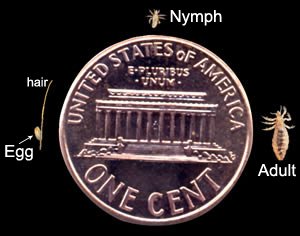About Human Head Lice in Virginia Beach
When an egg/nit hatches, it releases a nymph. The nit shell stays attached to the hair via the nit glue, the nit shell turns a dull yellow to white translucent color and may be mistaken for dandruff. The nymph (baby bug) looks like an adult louse but is smaller. As the nymph grows, it molts out of its exoskeleton 3 times before it becomes an adult within 7 to 9 days.
Facts of Lice
The female will lay eggs 3 to 6 eggs/nits a day that is and they will hatch within 7 to 11 days. If you see eggs, you have lice or had an egg-laying female louse in your hair at one time.

The newly hatched nymph takes 8 to 9 days to become an adult; the age at which a female starts laying eggs. Most people find they have lice in the 3rd or 4th week of being infected.
Lice eggs need a perfect environment to survive (our heads) and if hatched off the head, they must feed quickly to survive. “In fact, head-to-head contact is usually required for them to spread”, says Harvard entomologist Richard Pollack, Ph.D., “and if they’re not on ahead, they get dehydrated and die very quickly. “After about a day without a meal they starve to death,” says Pollack.
Mature lice and viable eggs (when it has a bug inside) usually appear tan or coffee-colored. Eggs when empty (already hatched) and nymphs can be translucent or clear in color. Adult lice have six legs and are about the size of a sesame or strawberry seed. Lice cannot jump or fly; they simply crawl.
Their claw-like hooks on the end of each leg help the lice to stay attached to your hair. Lice prefer hiding in your hair at the base of your neck and around your ears. (These are called “hot spots”.) But in heavy cases, you can find them in the crown, bangs or any other place on the head. Over the decade that we have been treating we are now noticing lice in the bangs and at the crown of the head & consider these “hot spots” as well.
Although head lice may be embarrassing and occasionally uncomfortable, they are not known to cause significant illness. You can read more about the subject of disease and lice at the NPA (National Pediculosis Association)

